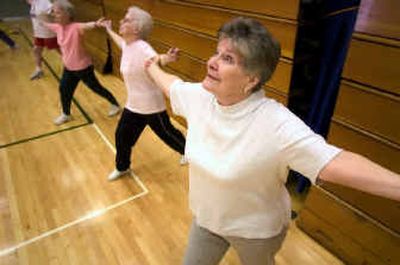Fighting youth decay

Chris Crowley is on a mission. Here is what he wants you to know: It’s possible not only to age more gracefully than you suspect but actually “to turn back your biological clock.” He’s not joking. Forget the fact that he’s trying to sell something. Sure, Crowley, a 70-year-old New York lawyer (now retired), is on the road hawking a book that he co-wrote with Henry S. Lodge, M.D. But the things he says during a phone interview about the book, “Younger Next Year: A Guide to Living Like 50 Until You’re 80 and Beyond” (Workman, 321 pages, $24.95), make sense.
And I’m not the only who believes this.
“Here, wait,” Crowley says, “I want to read you my favorite review. It’s from the Washington Post. The reviewer writes, ‘I was going to throw it right in the this-is-baloney pile. That would have been a mistake.’ Then he goes on and, remember this is the Washington Post, ‘It’s brain-rattling, irresistible, hilarious. If you’re up for it and anywhere near retirement, it can change your life.’ “
Crowley and Lodge, a 46-year-old internist, take more than 300 pages to say two main things.
The first is that, as Lodge wrote, “There is a critical difference between aging and decay. We are stuck with real aging, but decay is optional.”
Lodge defines decay as the process of giving up. It occurs when you convince yourself that getting older means necessarily slowing down, and it becomes a self-fulfilling prophecy that is passed down to your very cells.
Second, overcoming, and even reversing, the decay involves a fairly simple process.
“The keys to overriding the decay code are daily exercise, emotional commitment, reasonable nutrition and a real engagement with living,” Lodge wrote.
Exercise, Lodge emphasizes, is the starting point.
“Being sedentary is the most important signal for decay,” he wrote. “Your body tissues and neural circuits are always trying to decay. Muscle, bone, brain: always trying to melt, like ice-cream cones in the sun.”
Merri Lou Franzella, program director of Gold’s Gym on Spokane’s North Side, says much the same thing.
“You can help diminish – not stop but diminish – the aging effect,” Franzella says.
Quoting stats provided by the American College of Sports Medicine, Franzella says that osteoporosis – a disease that weakens bone and affects women more than men – causes 1.2 million bone fractures a year.
“Exercise,” says Franzella, “is what helps maintain your strength and your bone density.”
Nutrition is key, says Shelly Walker of the Coeur d’Alene Pilgrim’s Nutrition store, because ingesting the wrong food will “tax your immune system and put you at great risk of being chronically ill and setting yourself up for debilitating diseases.”
Walker’s advice: Eat whole foods.
“Our body itself is a living organism, so putting living foods in it is what’s going to minister life to those cells,” she says. By eating processed foods, Walker adds, “You’re robbing the body of nutrients. It’s just like going to the bank. You’re withdrawing things from your system.”
As for commitment and an engagement with living, those come from maintaining an interest in life and all it has to offer.
“I know younger people want to be social,” says Vicki Marsh, health and fitness coordinator for the downtown YMCA, “but older people do, too. They tend to get in the house and they stay stuck because they feel like they can’t go anywhere … A lot of them say, ‘Well, I’m just going to sit.’ The worst thing they can do is sit. They need to move.”
And Marsh, who teaches classes for what she calls “active older adults,” says that the connection her students make in class are almost as important as the exercise itself.
“These people look forward to their workout three days a week,” Marsh says. “It’s the togetherness, the friendships that you develop. Yeah, it’s about exercising, but you have to look at the whole package.”
Which brings us back to Crowley and Lodge. The two authors met each other after Crowley, overweight and out of shape, had been sent to Lodge for help.
“I’d always had an idea about some sort of book like this, aimed at baby-boom men,” Crowley says. “And frankly the exercise stuff I knew about a little bit. But then I meet Harry, and he was really into it, talking about ‘the revolution,’ blah-blah-blah. And I said to him, ‘We’re going to write a book together.’ “
What Lodge called “the revolution” is the attitude, based on a new view of science, which claims – Lodge wrote – that “ailments and deterioration are not a normal part of growing old. They are an outrage. An outrage that we have simply gotten used to because we set the bar so shamefully low.”
“The things we tell folks to think about are familiar,” says Crowley. “But ours is a ‘why-to’ not a ‘how-to’ book. We don’t lecture. But once you know how your body works, it’s a little harder to ignore things.”
And if there is a model for what “Younger Next Year” proposes, it’s Crowley himself.
“In my early 60s, I started to hurt,” he says. “My hips hurt, my knees hurt, my feet hurt. It hurt to reach up for the cereal. I was starting to creak. But so help me, since I’ve been doing this – the weights especially – it’s all gone away. Now, it’ll be back, I guess. But it ain’t here yet. And that’s a blessing.”